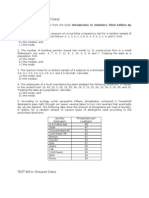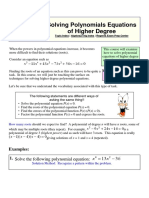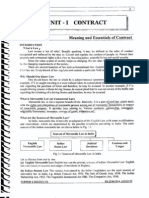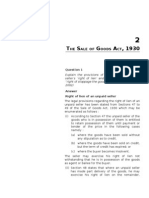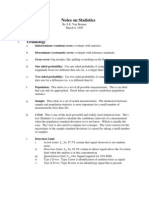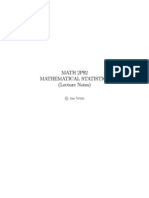Math Ratio & Proportion
Math Ratio & Proportion
Uploaded by
Vishal GattaniCopyright:
Available Formats
Math Ratio & Proportion
Math Ratio & Proportion
Uploaded by
Vishal GattaniCopyright
Available Formats
Share this document
Did you find this document useful?
Is this content inappropriate?
Copyright:
Available Formats
Math Ratio & Proportion
Math Ratio & Proportion
Uploaded by
Vishal GattaniCopyright:
Available Formats
CPT Business Mathematics / Ratio & Proportion
Gurudev Tutorials
RATIO
Ratio:- Ratio is a comparison of two or more quantities of the same kind
by division (they must be in same units too). i.e. a/b is called ratio of a to b. it can be written as a:b (read as a is to b or a ratio b). a and b are called the terms of the ratio, a is called first term or antecedent and b is called second term or consequent.
Remarks:
Both terms of ratio can be multiplied or divided by same (non-zero) number. Usually a ratio is expressed in the lowest term (or simplest form). Ratio exists only between quantities of the same kind. Quantities to be compared (by division) must be in the same units. The order of the terms in ratio is important. To compare to ratios, convert them into equivalent like fractions. If a quantity is increased in the ratio a:b then new quantity = b/a times of the original quantity. o The fraction by which the original quantity is multiplied to get a new quantity is called the multiplying ratio (factor).
Inverse Ratio:- One ratio is inverse of another if their product is 1. Thus
a:b is the inverse ratio of b/a and vice versa.
A ratio a:b is said to be of greater inequality if a > b and less inequality if a < b. The ratio compounded of the two ratios a:b and c:d is ac:bd. A ratio compounded of itself is called its Duplicate ratio. Thus a2 : b2 is the duplicate ratio of a:b. Similarly, a3 : b3 is the Triplicate ratio of a:b. Sub-Duplicate ratio of a:b is a1/2 : b1/2. Sub-Triplicate ratio of a:b is a1/3: b1/3. If the ratio of two similar quantities can be expressed as a ratio of two integers, the quantities are said to be commensurable; otherwise, they are said to be incommensurable. 31/2:21/2 cannot be expressed as the ratio of two integers and therefore, 31/2 and 21/2 are incommensurable quantities.
Page 1 of 4
Compiled by CA Naveen Kumar Agrawal, +91 92164 08902.
CPT Business Mathematics / Ratio & Proportion
Gurudev Tutorials
Continued Ratio:- Continued Ratio is the relation (or comparison)
between the magnitudes of the same kind. The continued ratio of three similar quantities a, b, c is written as a : b : c.
Some Techniques:
1.
If there are three quantities which are expressed into two ratios, e.g. let A, B & C are three quantities such that A:B = a:b and B:C = c:d then Combined Ratio of all the three quantities will be ac:bc:bd. A : B : C a : b c ac : bc : : d bd
Note: Common quantity in the given two ratios should be placed between the other two quantities. For this necessary adjustment should be done in the ratio/s. 2. Divide the given Quantity / Amount in to given Ratio. Let A is to be divide in the ratio a:b:c, Then, First part = (a*A)/(a+b+c) Second part = (b*A)/(a+b+c) Third part = (c*A)/(a+b+c) Alternatively, this can also be done in the following manner: Let the three parts are ax, bx & cx respectively Then, ax + bx+ cx = A x (a + b + c) = A x = A / (a + b + c) after finding the value of x calculate each part by multiplying the value of x with a, b & c respectively.
Page 2 of 4
Compiled by CA Naveen Kumar Agrawal, +91 92164 08902.
CPT Business Mathematics / Ratio & Proportion
Gurudev Tutorials
PROPORTION
Proportion: An equality of two ratios is called a Proportion.
Four quantities are said to be in proportion if a : b = c : d (also written as a:b :: c:d). a / b = c / d ad = bc a, b, c, d are called the terms of the proportion
First & fourth terms are called extremes. Second & third terms are called means (or middle terms). Product of extremes = Product of means. (Cross Product Rule)
Continued Proportion: When three or more numbers are so related
that the first to the second, the ratio of the second to the third, third to fourth, etc. are all equal, the numbers are said to be in continued proportion. Written as: a/b = b/c = c/d = d/e = when a, b, c, d, e are in continued proportion. If a, b, c are in continued proportion, then middle term b is called the mean proportional between the first proportional a and third proportional c. a:b=b:c b2 = ac b = (ac)1/2 If a ratio is equal to the reciprocal of the other, then either of them is in inverse (reciprocal) proportion of the other. e.g. 3/4 is in inverse proportion of 4/3 and vice versa. Note: In a ratio both quantities must be of the same kind while in the proportion all the four quantities need not be of the same type. The first two quantities should be of the same kind and last two quantities should be of the same kind.
Properties of proportion:
1. 2. 3. 4. 5.
If a : b = c : d, then ad = bc (By cross multiplication) If a : b = c : d, then b : a = d : c (Invertando) If a : b = c : d, then a: c = b : d (Alternando) If a : b = c : d, then (a + b) : b = (c + d) : d (Componando) If a : b = c : d, then (a - b) : b = (c - d) : d (Dividendo)
Compiled by CA Naveen Kumar Agrawal, +91 92164 08902.
Page 3 of 4
CPT Business Mathematics / Ratio & Proportion 6. If a : b = c : d, then (a + b) : (a b) 7. 8.
Gurudev Tutorials
= (c + d) : (c d) (Componando &
Dividendo) If a : b = c : d = e : f = .., then (a + c + e + .) : (b + d + f +.) (Addendo) If a : b = c : d = e : f = .., then (a - c - e - .) : (b - d - f - .) (Subtrahendo)
Page 4 of 4
Compiled by CA Naveen Kumar Agrawal, +91 92164 08902.
You might also like
- Medix Ability Test 12Document14 pagesMedix Ability Test 12Abigail ForbesNo ratings yet
- Section 1.3: Algebraic Expressions: Grade 7 Math Unit 1 Notes: Patterns & RelationsDocument2 pagesSection 1.3: Algebraic Expressions: Grade 7 Math Unit 1 Notes: Patterns & Relationsapi-288922072100% (1)
- 17 Laws of ExponentsDocument6 pages17 Laws of Exponentsapi-299265916No ratings yet
- 5-10 Scale Factor Perimeter and AreaDocument2 pages5-10 Scale Factor Perimeter and AreaAndalsridevi LingamNo ratings yet
- Grade 7 Math Test: Student Name DateDocument7 pagesGrade 7 Math Test: Student Name Dateruel pabloNo ratings yet
- Algebraic Thinking Lesson PlanDocument3 pagesAlgebraic Thinking Lesson Planapi-284504897No ratings yet
- Linear Equation Word ProblemsDocument1 pageLinear Equation Word ProblemsChlephz DmNo ratings yet
- Exercises in Measure of Central Tendency-Grouped and Ungrouped DataDocument3 pagesExercises in Measure of Central Tendency-Grouped and Ungrouped DataVishal Gattani93% (42)
- Lecture6 The Fast Decoupled MethodDocument25 pagesLecture6 The Fast Decoupled Methodleo232No ratings yet
- Commutative Algebra Bourbaki PDFDocument2 pagesCommutative Algebra Bourbaki PDFSteve0% (2)
- Lesson 4.8 - Least Common MultipleDocument21 pagesLesson 4.8 - Least Common MultipleehystadNo ratings yet
- Two-Variable Linear Inequalities Word ProblemsDocument3 pagesTwo-Variable Linear Inequalities Word ProblemsJoh TayagNo ratings yet
- 8th Grade Math Welcome Letter 2015Document3 pages8th Grade Math Welcome Letter 2015api-261254189No ratings yet
- Semester Exam Reviewer: Grade 7 (Real Numbers, Basic Algebra, Linear Equation, Linear Functions and Graphs)Document2 pagesSemester Exam Reviewer: Grade 7 (Real Numbers, Basic Algebra, Linear Equation, Linear Functions and Graphs)Jocelyn Beatrice MihardjaNo ratings yet
- Quiz 2.6 QuadrilateralsDocument3 pagesQuiz 2.6 QuadrilateralsRomeo Madrona JrNo ratings yet
- Volume and Surface Area of Prisms HomeworkDocument3 pagesVolume and Surface Area of Prisms Homeworkroch ajionoNo ratings yet
- Absolute Value Inequality Word ProblemsDocument2 pagesAbsolute Value Inequality Word ProblemsShardulMaurya0% (2)
- Age ProblemsDocument20 pagesAge ProblemsAli Syed100% (1)
- Ratio and Proportion BCSDocument10 pagesRatio and Proportion BCSB. M. SHOFIQUL ISLAM100% (1)
- Geometry and TrigonometryDocument25 pagesGeometry and TrigonometryDane SinclairNo ratings yet
- Math Review-Part 1Document39 pagesMath Review-Part 1LouiseNo ratings yet
- Ixl Summer 2020 5thDocument2 pagesIxl Summer 2020 5thapi-298712317No ratings yet
- Polynomial Division Problem and Its Synthetic CounterpartDocument2 pagesPolynomial Division Problem and Its Synthetic CounterpartJerson YhuwelNo ratings yet
- Commutative, Associative and Distributive Laws: Wow! What A Mouthful of Words! But The Ideas Are SimpleDocument6 pagesCommutative, Associative and Distributive Laws: Wow! What A Mouthful of Words! But The Ideas Are SimpleAnnisa RohmahNo ratings yet
- Sample Paper OGDCL NTHP 2018 April 2 2018 2Document4 pagesSample Paper OGDCL NTHP 2018 April 2 2018 2Syed Atiq TurabiNo ratings yet
- Algebra Word Problems 1Document2 pagesAlgebra Word Problems 1David SitumorangNo ratings yet
- Chapter 4 Mathematical Reasoning ExampleDocument5 pagesChapter 4 Mathematical Reasoning ExampleSheila KhairiNo ratings yet
- Tests For ParallelogramsDocument27 pagesTests For Parallelogramssunita agreyNo ratings yet
- Writing Equations From Word ProblemsDocument6 pagesWriting Equations From Word ProblemsLeslie CameronNo ratings yet
- ExponentsDocument5 pagesExponentsarmailgm100% (1)
- Quiz - 3 - Grade8Document1 pageQuiz - 3 - Grade8Dizon MRaineNo ratings yet
- Math Final Exam Grade 7Document3 pagesMath Final Exam Grade 7indahpriliatyNo ratings yet
- Everything About Parallelograms - Squares - Rectangles - RhombusDocument30 pagesEverything About Parallelograms - Squares - Rectangles - RhombusGilbertNo ratings yet
- Math 8 First Summative Q2Document2 pagesMath 8 First Summative Q2DI AN NE100% (1)
- 4.2 Congruence of Triangles (Reflexive, Symetric, Transitive)Document22 pages4.2 Congruence of Triangles (Reflexive, Symetric, Transitive)MiiMii Imperial Ayuste100% (1)
- G9 Geometry Diagnostic TestDocument3 pagesG9 Geometry Diagnostic Testomama_thNo ratings yet
- Solving Higher Order PolynomialsDocument3 pagesSolving Higher Order PolynomialsDVS2monaNo ratings yet
- LET Reviewer Biology Part 1Document4 pagesLET Reviewer Biology Part 1Gemma HernandezNo ratings yet
- MATH 7 ReviewerDocument6 pagesMATH 7 ReviewerJoy Cabato BaynoNo ratings yet
- Pre Calculus SyllabusDocument4 pagesPre Calculus SyllabusMatthew GriffinNo ratings yet
- Grade 9 Geometry ReviewDocument2 pagesGrade 9 Geometry ReviewMelissaNo ratings yet
- 4 Ratio, Proportion, and VariationDocument34 pages4 Ratio, Proportion, and VariationBoom Box100% (2)
- Converting Fractions To Decimals: Name DateDocument1 pageConverting Fractions To Decimals: Name DateTarek NubaniNo ratings yet
- Laws of ExponentsDocument3 pagesLaws of ExponentsJacqueline NaranjaNo ratings yet
- 1.2 - Characteristics of Polynomial FunctionsDocument5 pages1.2 - Characteristics of Polynomial FunctionsPavni ChandaniNo ratings yet
- Parallel Lines and TransversalsDocument29 pagesParallel Lines and TransversalsSamanthaSebastianNo ratings yet
- Factoring Quadratic Equations WorksheetDocument4 pagesFactoring Quadratic Equations WorksheetpssrijitNo ratings yet
- Worksheet On Algebraic FractionsDocument21 pagesWorksheet On Algebraic Fractionsmathsman9100% (1)
- Fundamental and Counting PrincipleDocument47 pagesFundamental and Counting PrincipleDrumz Staff100% (4)
- Edit and Improve Sentences Activity SheetsDocument24 pagesEdit and Improve Sentences Activity Sheetsjn4035No ratings yet
- Grade 5 Performance TaskDocument5 pagesGrade 5 Performance TaskSubrinie WrayNo ratings yet
- DecimalsDocument25 pagesDecimalsLaisa BartoloNo ratings yet
- Problems On Ratios and ProportionsDocument13 pagesProblems On Ratios and ProportionsJenson DonNo ratings yet
- Lanao Del Norte-Unit 2-Module 5 Lesson 1 Systems of Linear Equation in Two VariablesDocument33 pagesLanao Del Norte-Unit 2-Module 5 Lesson 1 Systems of Linear Equation in Two VariablesmusicaBG100% (3)
- Permutations & CombinationsDocument27 pagesPermutations & CombinationsVimal SamuthiravelNo ratings yet
- Vocabulary (Questions)Document11 pagesVocabulary (Questions)Mark Anthony Javellana SicadNo ratings yet
- GRE Equations and Inequalities QuestionsDocument11 pagesGRE Equations and Inequalities QuestionsNeha SardaNo ratings yet
- Ratio & ProportionDocument8 pagesRatio & ProportionMbatutesNo ratings yet
- Iready Sample Diagnostic Items MathDocument4 pagesIready Sample Diagnostic Items Mathapi-379755793No ratings yet
- Lesson 4.1 - Prime FactorizationDocument21 pagesLesson 4.1 - Prime FactorizationehystadNo ratings yet
- Ratio and Proportion, AgrawalDocument4 pagesRatio and Proportion, AgrawalShrishailamalikarjunNo ratings yet
- 3Document15 pages3priyanshNo ratings yet
- The Indian Contract Act 1872Document47 pagesThe Indian Contract Act 1872Dilfaraz KalawatNo ratings yet
- Pre Qs. PaperDocument48 pagesPre Qs. PaperSidharth Singh AntilNo ratings yet
- Sale of Goods Act 1930Document12 pagesSale of Goods Act 1930Vishal GattaniNo ratings yet
- Contract ActDocument5 pagesContract ActVishal GattaniNo ratings yet
- 43 - The Indian Contract Act 1872Document5 pages43 - The Indian Contract Act 1872Sanjeev Kumar TirthaniNo ratings yet
- Sale of Goods Act 1930Document12 pagesSale of Goods Act 1930Vishal GattaniNo ratings yet
- Law Contract Act. BasicnsDocument31 pagesLaw Contract Act. BasicnsVishal GattaniNo ratings yet
- Indian Contract ActDocument8 pagesIndian Contract ActjjmainiNo ratings yet
- Contract Act 1872Document38 pagesContract Act 1872Vishal GattaniNo ratings yet
- Contract Act 1872Document69 pagesContract Act 1872Vishal GattaniNo ratings yet
- Chapter-2 The Sale of Goods Act, 1930Document27 pagesChapter-2 The Sale of Goods Act, 1930Vishal GattaniNo ratings yet
- Chapter-1 The Indian Contract Act, 1872Document39 pagesChapter-1 The Indian Contract Act, 1872Vishal GattaniNo ratings yet
- CPT Mercantile Law Dharmendra Madaan 3Document21 pagesCPT Mercantile Law Dharmendra Madaan 3Viswanathan Ramakrishnan50% (2)
- Chapter-3 The Indian Partnership Act, 1932Document22 pagesChapter-3 The Indian Partnership Act, 1932Vishal Gattani100% (8)
- Statistc in ChemistryDocument13 pagesStatistc in Chemistrycinvehbi711No ratings yet
- Notes 424 03Document164 pagesNotes 424 03Muhammad Shafaat AwanNo ratings yet
- 0CPT Scanner (Paper2) Appendix Dec 09Document3 pages0CPT Scanner (Paper2) Appendix Dec 09Vishal GattaniNo ratings yet
- Stat Defn BookletDocument9 pagesStat Defn BookletVishal GattaniNo ratings yet
- Statistics 333Document84 pagesStatistics 333Vishal Gattani100% (1)
- CPT MathDocument2 pagesCPT MathVishal GattaniNo ratings yet
- CAT 6 Months Ultimate ProgramDocument8 pagesCAT 6 Months Ultimate Programashrut destructionNo ratings yet
- 2D Array Practice QuestionsDocument2 pages2D Array Practice QuestionsThakur Varun Singh JadounNo ratings yet
- MATLAB Linear Algebra FunctionsDocument15 pagesMATLAB Linear Algebra FunctionsAhmed HwaidiNo ratings yet
- SS1 FURTHER MATHS EXAMDocument8 pagesSS1 FURTHER MATHS EXAMezekielfavour467No ratings yet
- Westmont College Student Solutions Manual: Probability and Statistics, Fourth Edition, by Hogg and CraigDocument61 pagesWestmont College Student Solutions Manual: Probability and Statistics, Fourth Edition, by Hogg and CraigLandon MoirNo ratings yet
- AMC Practice Problems Solutions Set1 MPRDocument3 pagesAMC Practice Problems Solutions Set1 MPRPaula Ty-RelucioNo ratings yet
- Multivector Calculus: Journal of Mathematical Analysis AND ApplicationsDocument13 pagesMultivector Calculus: Journal of Mathematical Analysis AND ApplicationsCloue Contad DeriadaNo ratings yet
- Assignement - 2 (Compound Angles)Document3 pagesAssignement - 2 (Compound Angles)Pratham MoreNo ratings yet
- Maths Assignment Unit 1Document3 pagesMaths Assignment Unit 1Madhu MitaNo ratings yet
- Course Handout Math-Ii (Ma 1004) PDFDocument4 pagesCourse Handout Math-Ii (Ma 1004) PDFAditi SrivastavaNo ratings yet
- Important Questions For Class 10 Maths by Padhai Ak Mazza 2024Document569 pagesImportant Questions For Class 10 Maths by Padhai Ak Mazza 2024velosityismygameNo ratings yet
- JH-2 Mathematics Chapter 1-Lesson 2Document3 pagesJH-2 Mathematics Chapter 1-Lesson 2Dhira Thalia AritonangNo ratings yet
- 15EC205 - Signals and Systems SyllabusDocument2 pages15EC205 - Signals and Systems Syllabusbashyam88No ratings yet
- Warm Up Lesson Presentation Lesson QuizDocument32 pagesWarm Up Lesson Presentation Lesson QuizDima TabeshNo ratings yet
- MATRICES & Determinants HOME WORKDocument25 pagesMATRICES & Determinants HOME WORKSk mNo ratings yet
- Exercises MatricsDocument3 pagesExercises MatricsAlena MansikaNo ratings yet
- Matrices Inter First Year ImportantDocument11 pagesMatrices Inter First Year ImportantSyed Salman83% (6)
- Cet Reviewer: Algebra 1: Identify The Choice That Best Completes The Statement or Answers The QuestionDocument4 pagesCet Reviewer: Algebra 1: Identify The Choice That Best Completes The Statement or Answers The QuestionAlfredo L. CariasoNo ratings yet
- Math LinksDocument16 pagesMath LinksMarlo Lao BernasolNo ratings yet
- Cbse Cl10 Otq Term 2 MathematicsDocument92 pagesCbse Cl10 Otq Term 2 MathematicsGiriBabuNo ratings yet
- Meet 4 Answers: 1. Arithmetic With Literal EquationsDocument11 pagesMeet 4 Answers: 1. Arithmetic With Literal EquationsMadeline NobleNo ratings yet
- Co-2 Material MfeDocument26 pagesCo-2 Material MfeAswith ReddyNo ratings yet
- Maths Ian Jacques 8th Ed Title PDFDocument7 pagesMaths Ian Jacques 8th Ed Title PDFgabboudeh100% (1)
- Affine Algebraic GeometryDocument21 pagesAffine Algebraic GeometryKevin MarroquínNo ratings yet
- Graphs of Inverse FunctionsDocument7 pagesGraphs of Inverse FunctionsCristy Yanto RacinesNo ratings yet
- Notes Fys4480Document117 pagesNotes Fys4480zahraa allamiNo ratings yet
- Patterns and Numbers in Nature and The World (Fibonacci Sequence and Golden Ratio)Document2 pagesPatterns and Numbers in Nature and The World (Fibonacci Sequence and Golden Ratio)Liznaire Tumblod100% (1)
- Ometry 2Document5 pagesOmetry 2Gladwin BuquironNo ratings yet







